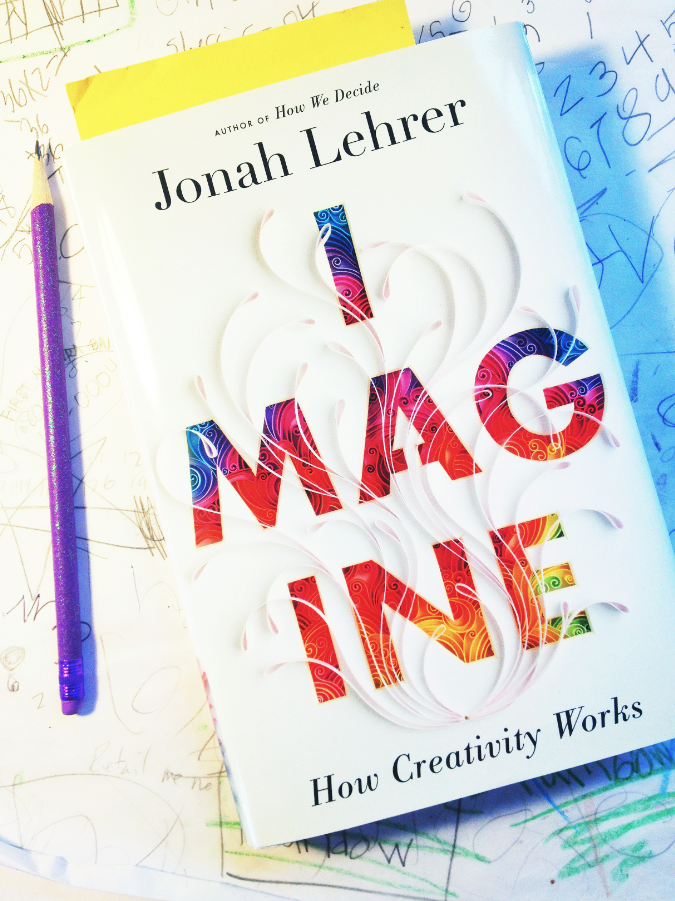The ability to tap into our creativity whenever we need it is paramount to being successful graphic designer. This is true for many other professions as well which is what prompted me to pick up and read this book, “Imagine – How Creativity Works”, because it promised to pinpoint our personal eternal spring of ideas. There were some very interesting case studies given (the inspiration for sticky notes and impetus for the Swifter mop, for example), along with some groundwork as to how to place ourselves in environments that will heighten our abilities to be creative. There were also some solid take-aways that are still stuck with me a month after completing this book.
The book is divided into two sections – Alone and Together. The first section, Alone, involves how creativity works for us as individuals and is, at first, very dense and scientific. However, there is a payoff to understanding how we solve problems, and that is being able to put ourselves in that position to better recreate an environment allowing us to tap into that part of our brain. It’s complicated, but the author, Jonah Lehrer, has a writing style that takes the complicated and simplifies it beautifully.
Here are some of my most important take aways from the book:
- Learn to be hyper-focused.
- Be unafraid. It is good to be thrown off guard. Letting yourself go and re-learning how to be unafraid to make mistakes are the keys to allowing our creativity to flow freely.
- Travel often. Traveling seems to free the imagination, and why the young (who haven’t learned all sorts of rules) are often more innovative than their elders. Even better, Lehrer suggests the longer we are away from home, the stronger our insight becomes.
- Make connections. Talk to people outside of you profession. Mingle. This is how our brain solve difficult problems and invent new ideas – by putting our knowledge together with other ideas to reach a solution. It’s called “outsider thinking”. Lehrer writes, “We are not biologically destined to get less creative … creativity doesn’t have to slip away.” We just need to continue to have an outsiders perspective and keep finding new challenges – stay curious – and we can think like a young person forever. Piacasso understood this and famously said, “Every child is an artist. The problem is how to remain an artist once we grow up.”
- “Not everyone can become a great artist, but a great artist can come from anywhere.” ~Anton Ego, in Pixar’s “Ratatouille”
- Lehrer writes, “Sometimes a creative problem is so difficult that it requires people to connect their imaginations together, the answer arrives only if we collaborate.”
- The impulse is for us to collaborate with the people we know and are comfortable with but that’s the exact wrong thing to do. If you really want to make be creative and invent something new, collaborate with some new people, too. Bring together a diversity of talent and allow them to interact freely.
- “There’s just one problem with brainstorming. It doesn’t work”, states Lehrer. “We can only get it right when we talk about what we got wrong.” A psychologist at UC- Berkeley summarizes her research results: “While the instructions ‘Do not criticize’ is often cited as the [most] important instruction in brainstorming, this appears to be a counterproductive strategy … when everybody is “right” – when all new ideas are equally useful, as in a brainstorming session – we stay within ourselves. There is no incentive to think about someone else’s thoughts or embrace unfamiliar possibilities. And so the problem remains impossible. The absence of criticism has kept us all in the same place.”
- Hire the best people. Then, get out of their way.
- You never know when an idea will come so you need to pay attention and listen to everything. Let everything in.
Those were my favorite points in the book on creativity – but there are many more. It was definitely worth the read however, after reading this book, I learned of a scandal involving Jonah Lehrer including his misquoting and fabricating material resulting in copies of this book actually being pulled from the shelves.
While that tarnishes my opinion of Lehrer, I still found this book interesting and helpful – if taken in the context that all may not be as factual as I believed while reading it. It is extremely disappointing that the author lied and misrepresented himself – particularly on a book on being original, finding solutions, and being creative.
~Amy




